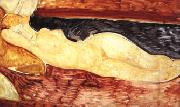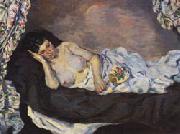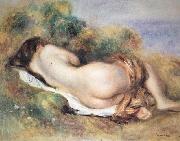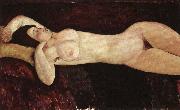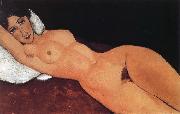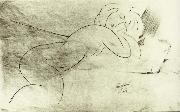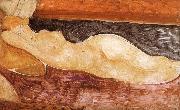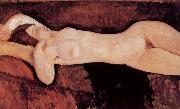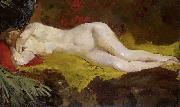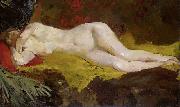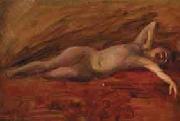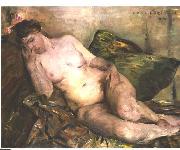Wholesale Oil Painting No Minimum |
|||||||||||
|
|
|||||||||||

|
|||||||||||
|
|
|
||||||||
Amedeo ModiglianiItalian Expressionist Painter and Sculptor, 1884-1920 Amedeo Clemente Modigliani (July 12, 1884 ?C January 24, 1920) was an Italian artist of Jewish heritage, practicing both painting and sculpture, who pursued his career for the most part in France. Modigliani was born in Livorno (historically referred to in English as Leghorn), in northwestern Italy and began his artistic studies in Italy before moving to Paris in 1906. Influenced by the artists in his circle of friends and associates, by a range of genres and art movements, and by primitive art, Modigliani's œuvre was nonetheless unique and idiosyncratic. He died in Paris of tubercular meningitis, exacerbated by poverty, overworking, and an excessive use of alcohol and narcotics, at the age of 35. |
||||||||
|
|
||||||||
Reclining Nude
Reclining Nude Painting ID:: 10535 |
1919, oil on canvas, 28 3/4 x 45 5/8 ins(73x116cm). Galleria Nazionale d'Arte Moderna, Rome. 1919, oil on canvas, 28 3/4 x 45 5/8 ins(73x116cm). Galleria Nazionale d'Arte Moderna, Rome. |
|||||||
|
|
||||||||
Armand GuillauminFrench Impressionist Painter, 1841-1927 French painter and lithographer. He grew up in Moulins, but at 16 he returned to Paris to find work. Despite the opposition of his working-class family, he prepared for an artistic career while he supported himself in municipal jobs. He started drawing classes and then enrolled in the Academie Suisse, where he met Cezanne and Camille Pissarro. Guillaumin began his career as an avant-garde artist by exhibiting with them at the Salon des Refus's in 1863. |
||||||||
|
|
||||||||
|
|
Reclining Nude
Reclining Nude Painting ID:: 11425 |
1' 7 1/4'' x 2' 1 1/2''(49 x 65 cm)Gift of Paul Gachet,1951 1' 7 1/4'' x 2' 1 1/2''(49 x 65 cm)Gift of Paul Gachet,1951 |
||||||
|
|
||||||||
Pierre RenoirFrench Impressionist Painter, 1841-1919 Pierre-Auguste Renoir (February 25, 1841?CDecember 3, 1919) was a French artist who was a leading painter in the development of the Impressionist style. As a celebrator of beauty, and especially feminine sensuality, it has been said that "Renoir is the final representative of a tradition which runs directly from Rubens to Watteau". Renoir's paintings are notable for their vibrant light and saturated color, most often focusing on people in intimate and candid compositions. The female nude was one of his primary subjects. In characteristic Impressionist style, Renoir suggested the details of a scene through freely brushed touches of color, so that his figures softly fuse with one another and their surroundings. His initial paintings show the influence of the colorism of Eugene Delacroix and the luminosity of Camille Corot. He also admired the realism of Gustave Courbet and Edouard Manet, and his early work resembles theirs in his use of black as a color. As well, Renoir admired Edgar Degas' sense of movement. Another painter Renoir greatly admired was the 18th century master François Boucher. A fine example of Renoir's early work, and evidence of the influence of Courbet's realism, is Diana, 1867. Ostensibly a mythological subject, the painting is a naturalistic studio work, the figure carefully observed, solidly modeled, and superimposed upon a contrived landscape. If the work is still a 'student' piece, already Renoir's heightened personal response to female sensuality is present. The model was Lise Tr??hot, then the artist's mistress and inspiration for a number of paintings. In the late 1860s, through the practice of painting light and water en plein air (in the open air), he and his friend Claude Monet discovered that the color of shadows is not brown or black, but the reflected color of the objects surrounding them. Several pairs of paintings exist in which Renoir and Monet, working side-by-side, depicted the same scenes (La Grenouill??re, 1869). One of the best known Impressionist works is Renoir's 1876 Dance at Le Moulin de la Galette (Le Bal au Moulin de la Galette). The painting depicts an open-air scene, crowded with people, at a popular dance garden on the Butte Montmartre, close to where he lived. On the Terrace, oil on canvas, 1881, Art Institute of ChicagoThe works of his early maturity were typically Impressionist snapshots of real life, full of sparkling colour and light. By the mid 1880s, however, he had broken with the movement to apply a more disciplined, formal technique to portraits and figure paintings, particularly of women, such as The Bathers, which was created during 1884-87. It was a trip to Italy in 1881, when he saw works by Raphael and other Renaissance masters, that convinced him that he was on the wrong path, and for the next several years he painted in a more severe style, in an attempt to return to classicism. This is sometimes called his "Ingres period", as he concentrated on his drawing and emphasized the outlines of figures. After 1890, however, he changed direction again, returning to the use of thinly brushed color which dissolved outlines as in his earlier work. From this period onward he concentrated especially on monumental nudes and domestic scenes, fine examples of which are Girls at the Piano, 1892, and Grandes Baigneuses, 1918-19. The latter painting is the most typical and successful of Renoir's late, abundantly fleshed nudes. A prolific artist, he made several thousand paintings. The warm sensuality of Renoir's style made his paintings some of the most well-known and frequently-reproduced works in the history of art.. |
||||||||
|
|
||||||||
|
|
Reclining Nude
Reclining Nude Painting ID:: 28679 |
c 1890
Oil on canvas 13'' x 16'' (33.5 x 41 cm)
The Norton Simon Foundation Pasadena California (mk64) c 1890 Oil on canvas 13'' x 16'' (33.5 x 41 cm) The Norton Simon Foundation Pasadena California (mk64) |
||||||
|
|
||||||||
Amedeo ModiglianiItalian Expressionist Painter and Sculptor, 1884-1920 Amedeo Clemente Modigliani (July 12, 1884 ?C January 24, 1920) was an Italian artist of Jewish heritage, practicing both painting and sculpture, who pursued his career for the most part in France. Modigliani was born in Livorno (historically referred to in English as Leghorn), in northwestern Italy and began his artistic studies in Italy before moving to Paris in 1906. Influenced by the artists in his circle of friends and associates, by a range of genres and art movements, and by primitive art, Modigliani's œuvre was nonetheless unique and idiosyncratic. He died in Paris of tubercular meningitis, exacerbated by poverty, overworking, and an excessive use of alcohol and narcotics, at the age of 35. |
||||||||
|
|
||||||||
|
|
Reclining Nude
Reclining Nude Painting ID:: 30904 |
mk68
Oil on canvas
New York
Museum of Modern Art
c.1917
Italy
mk68 Oil on canvas New York Museum of Modern Art c.1917 Italy |
||||||
|
|
||||||||
Amedeo ModiglianiItalian Expressionist Painter and Sculptor, 1884-1920 Amedeo Clemente Modigliani (July 12, 1884 ?C January 24, 1920) was an Italian artist of Jewish heritage, practicing both painting and sculpture, who pursued his career for the most part in France. Modigliani was born in Livorno (historically referred to in English as Leghorn), in northwestern Italy and began his artistic studies in Italy before moving to Paris in 1906. Influenced by the artists in his circle of friends and associates, by a range of genres and art movements, and by primitive art, Modigliani's œuvre was nonetheless unique and idiosyncratic. He died in Paris of tubercular meningitis, exacerbated by poverty, overworking, and an excessive use of alcohol and narcotics, at the age of 35. |
||||||||
|
|
||||||||
|
|
Reclining nude
Reclining nude Painting ID:: 53532 |
mk232
1917
Oil on canvas
60x92cm
mk232 1917 Oil on canvas 60x92cm |
||||||
|
|
||||||||
Amedeo ModiglianiItalian Expressionist Painter and Sculptor, 1884-1920 Amedeo Clemente Modigliani (July 12, 1884 ?C January 24, 1920) was an Italian artist of Jewish heritage, practicing both painting and sculpture, who pursued his career for the most part in France. Modigliani was born in Livorno (historically referred to in English as Leghorn), in northwestern Italy and began his artistic studies in Italy before moving to Paris in 1906. Influenced by the artists in his circle of friends and associates, by a range of genres and art movements, and by primitive art, Modigliani's œuvre was nonetheless unique and idiosyncratic. He died in Paris of tubercular meningitis, exacerbated by poverty, overworking, and an excessive use of alcohol and narcotics, at the age of 35. |
||||||||
|
|
||||||||
|
|
Reclining nude
Reclining nude Painting ID:: 53534 |
mk232
1917
Pencil on paper
26x41cm
mk232 1917 Pencil on paper 26x41cm |
||||||
|
|
||||||||
Amedeo ModiglianiItalian Expressionist Painter and Sculptor, 1884-1920 Amedeo Clemente Modigliani (July 12, 1884 ?C January 24, 1920) was an Italian artist of Jewish heritage, practicing both painting and sculpture, who pursued his career for the most part in France. Modigliani was born in Livorno (historically referred to in English as Leghorn), in northwestern Italy and began his artistic studies in Italy before moving to Paris in 1906. Influenced by the artists in his circle of friends and associates, by a range of genres and art movements, and by primitive art, Modigliani's œuvre was nonetheless unique and idiosyncratic. He died in Paris of tubercular meningitis, exacerbated by poverty, overworking, and an excessive use of alcohol and narcotics, at the age of 35. |
||||||||
|
|
||||||||
|
|
Reclining nude
Reclining nude Painting ID:: 53542 |
mk232
1918
Oil on canvas
73x116cm
mk232 1918 Oil on canvas 73x116cm |
||||||
|
|
||||||||
Amedeo ModiglianiItalian Expressionist Painter and Sculptor, 1884-1920 Amedeo Clemente Modigliani (July 12, 1884 ?C January 24, 1920) was an Italian artist of Jewish heritage, practicing both painting and sculpture, who pursued his career for the most part in France. Modigliani was born in Livorno (historically referred to in English as Leghorn), in northwestern Italy and began his artistic studies in Italy before moving to Paris in 1906. Influenced by the artists in his circle of friends and associates, by a range of genres and art movements, and by primitive art, Modigliani's œuvre was nonetheless unique and idiosyncratic. He died in Paris of tubercular meningitis, exacerbated by poverty, overworking, and an excessive use of alcohol and narcotics, at the age of 35. |
||||||||
|
|
||||||||
|
|
Reclining nude
Reclining nude Painting ID:: 53553 |
mk232
c.1919
Oil on canvas
72.4x116.5cm
mk232 c.1919 Oil on canvas 72.4x116.5cm |
||||||
|
|
||||||||
Lovis CorinthGerman Painter, 1858-1925 German painter and writer. He grew up on his family's farm and tannery. As a child he showed interest in art, taking informal lessons in drawing from a local carpenter and caricaturing his primary school teachers. Corinth's father sent him to secondary school in the nearby city of K?nigsberg (now Kaliningrad), where he lived with his widowed aunt. A superstitious woman fond of story-telling, she possessed what Corinth later described as a coarse temperament and an unrestrained, 'demonic' humour. These qualities and his aunt's bohemian acquaintances, including fortune-tellers and soothsayers, fascinated the young Corinth, accustomed to his more reserved parents. |
||||||||
|
|
||||||||
|
|
Reclining Nude
Reclining Nude Painting ID:: 54309 |
mk235
1899
Oil on canvas
75x120cm
mk235 1899 Oil on canvas 75x120cm |
||||||
|
|
||||||||
George Hendrik BreitnerDutch Painter, 1857-1923 Dutch painter and photographer. He trained as a painter and draughtsman at the academy in The Hague. Although the Dutch painter Charles Rochussen taught the students history and landscape painting, Breitner's interests did not lie in this area. In 1880 he worked for a year in the studio of Willem Maris after his academy training. Maris belonged to the Hague school of painters, who worked in the plein-air tradition of the French Barbizon school. Breitner painted outdoor life with them, although it was not the picturesqueness of the landscape or the Dutch skies that appealed to him. With Van Gogh he roamed the working-class districts of The Hague and through the dockyards of Rotterdam. Both artists recorded the vitality of city life in their sketchbooks. Breitner consciously chose these themes and motifs: he wanted to paint people going about their daily lives |
||||||||
|
|
||||||||
|
|
Reclining nude
Reclining nude Painting ID:: 83901 |
Date ca. 1887-1888
Medium Oil on canvas
Dimensions 95 x 146 cm (37.4 x 57.5 in)
cjr Date ca. 1887-1888 Medium Oil on canvas Dimensions 95 x 146 cm (37.4 x 57.5 in) cjr |
||||||
|
|
||||||||
George Hendrik BreitnerDutch Painter, 1857-1923 Dutch painter and photographer. He trained as a painter and draughtsman at the academy in The Hague. Although the Dutch painter Charles Rochussen taught the students history and landscape painting, Breitner's interests did not lie in this area. In 1880 he worked for a year in the studio of Willem Maris after his academy training. Maris belonged to the Hague school of painters, who worked in the plein-air tradition of the French Barbizon school. Breitner painted outdoor life with them, although it was not the picturesqueness of the landscape or the Dutch skies that appealed to him. With Van Gogh he roamed the working-class districts of The Hague and through the dockyards of Rotterdam. Both artists recorded the vitality of city life in their sketchbooks. Breitner consciously chose these themes and motifs: he wanted to paint people going about their daily lives |
||||||||
|
|
||||||||
|
|
Reclining nude
Reclining nude Painting ID:: 88271 |
1887-1888
Medium Oil on canvas
Dimensions 95 x 146 cm (37.4 x 57.5 in)
cyf 1887-1888 Medium Oil on canvas Dimensions 95 x 146 cm (37.4 x 57.5 in) cyf |
||||||
|
|
||||||||
William Woodward(1 May 1859 - 17 November 1939) was a U.S. artist and educator, best known for his impressionist paintings of New Orleans and the Gulf Coast of the United States. Woodward was born in Seekonk, Massachusetts. His younger brother Ellsworth Woodward also became a notable artist. William Woodward studied art at the Rhode Island School of Design, and later at the Academie Julian where he received instruction from Gustave Boulanger and Jules Lefebvre. View of the Napoleon House in New Orleans, 1904In 1884 Woodward was hired to teach fine art, mechanical drawing, and architectural drawing at Tulane University in New Orleans. He became interested in the history and architecture of the city, especially the old French Quarter, which at the time had become largely neglected with many of the historic structures in a state of decay. In 1895 he led a successful campaign to save the Cabildo from demolition. His series of paintings of French Quarter scenes helped shape awareness of the neighborhood's architectural heritage and spurred the formation of the Vieux Carre Commission to help preserve it. He started teaching architectural engineering at Tulane in 1894 and helped found the Tulane School of Architecture in 1907, as well as the Newcomb School of Art. In 1921 he suffered an accident and used a wheelchair for the rest of his life. He retired from Tulane the following year, and in 1923 moved to Biloxi, Mississippi. He invented the fiberloid dry etching process. He continued to paint and produce etchings for the rest of his life. |
||||||||
|
|
||||||||
|
|
Reclining Nude
Reclining Nude Painting ID:: 97041 |
oil on board, by William Woodward
Date 1907(1907)
cyf oil on board, by William Woodward Date 1907(1907) cyf |
||||||
|
|
||||||||
Lovis CorinthGerman Painter, 1858-1925 German painter and writer. He grew up on his family's farm and tannery. As a child he showed interest in art, taking informal lessons in drawing from a local carpenter and caricaturing his primary school teachers. Corinth's father sent him to secondary school in the nearby city of K?nigsberg (now Kaliningrad), where he lived with his widowed aunt. A superstitious woman fond of story-telling, she possessed what Corinth later described as a coarse temperament and an unrestrained, 'demonic' humour. These qualities and his aunt's bohemian acquaintances, including fortune-tellers and soothsayers, fascinated the young Corinth, accustomed to his more reserved parents. |
||||||||
|
|
||||||||
|
|
Reclining nude
Reclining nude Painting ID:: 97196 |
1910(1910)
Medium oil on canvas
cyf 1910(1910) Medium oil on canvas cyf |
||||||
|
|
||||||||
|
Lovis Corinth German Painter, 1858-1925 German painter and writer. He grew up on his family's farm and tannery. As a child he showed interest in art, taking informal lessons in drawing from a local carpenter and caricaturing his primary school teachers. Corinth's father sent him to secondary school in the nearby city of K?nigsberg (now Kaliningrad), where he lived with his widowed aunt. A superstitious woman fond of story-telling, she possessed what Corinth later described as a coarse temperament and an unrestrained, 'demonic' humour. These qualities and his aunt's bohemian acquaintances, including fortune-tellers and soothsayers, fascinated the young Corinth, accustomed to his more reserved parents. Reclining nude 1910(1910) Medium oil on canvas cyf |
||||||||
|
|
||||||||
|
Prev Next
|
||||||||
|
|
||||||||
|
Related Paintings to Lovis Corinth :. |
||||||||
|
|
||||||||
|
CONTACT US |
